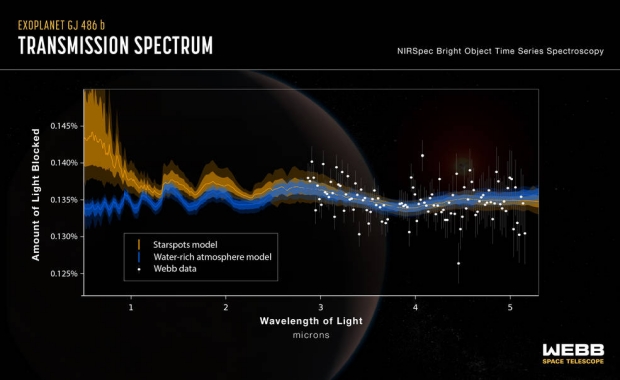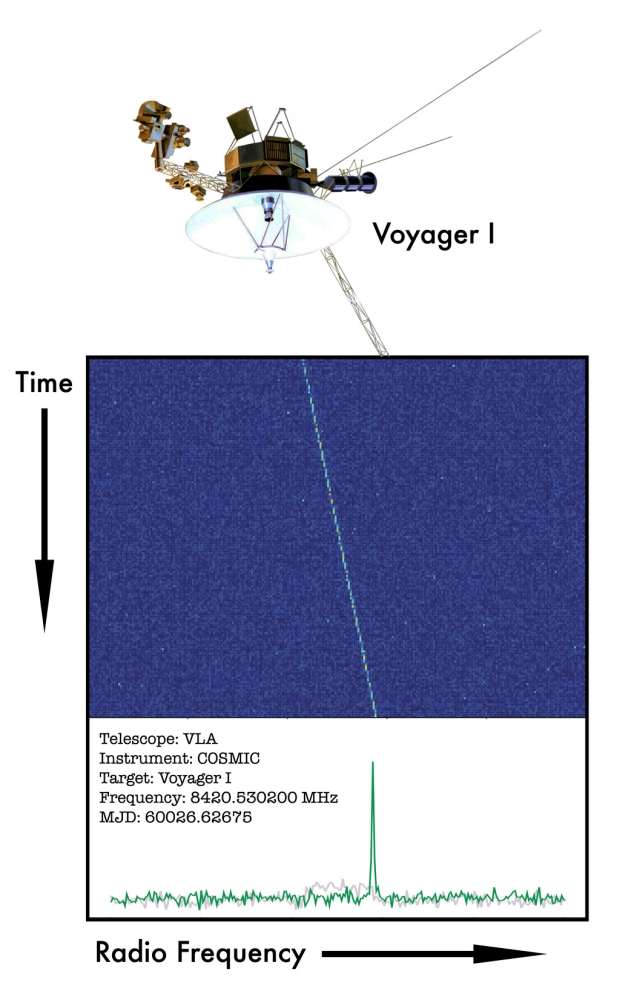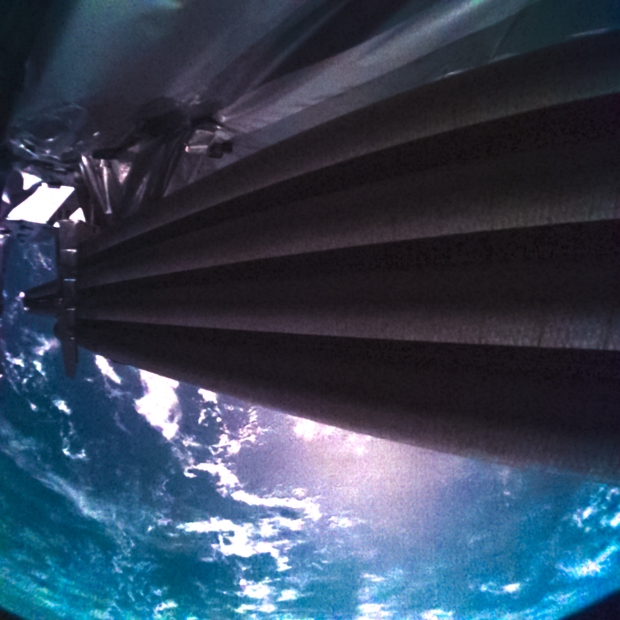With landers on places like Enceladus conceivable in the not distant future, how we might recognize extraterrestrial life if and when we run into it is no small matter. But maybe we can draw conclusions by addressing the complexity of an object, calculating what it would take to produce it. Don Wilkins considers this approach in today's essay as he lays out the background of Assembly Theory. A retired aerospace engineer with thirty-five years experience in designing, developing, testing, manufacturing and deploying avionics, Don tells me he has been an avid supporter of space flight and exploration all the way back to the days of Project Mercury. Based in St. Louis, where he is an adjunct instructor of electronics at Washington University, Don holds twelve patents and is involved with the university’s efforts at increasing participation in science, technology, engineering, and math. Have a look at how we might deploy AT methods not only in our system but around other stars. by Don...
Game Changer: Exploring the New Paradigm for Deep Space
The game changer for space exploration in coming decades will be self-assembly, enabling the growth of a new and invigorating paradigm in which multiple smallsat sailcraft launched as ‘rideshare’ payloads augment huge ‘flagship’ missions. Self-assembly allows formation-flying smallsats to emerge enroute as larger, fully capable craft carrying complex payloads to target. The case for this grows out of Slava Turyshev and team’s work at JPL as they refine the conceptual design for a mission to the solar gravitational lens at 550 AU and beyond. The advantages are patent, including lower cost, fast transit times and full capability at destination. Aspects of this paradigm are beginning to be explored in the literature, as I’ve been reminded by Alex Tolley, who forwarded an interesting paper out of the University of Padua (Italy). Drawing on an international team, lead author Giovanni Santi explores the use of CubeSat-scale spacecraft driven by sail technologies, in this case ‘lightsails’...
An Ice Giant’s Possible Oceans
Further fueling my interest in reaching the ice giants is a study in the Journal of Geophysical Research: Planets that investigates the possibility of oceans on the major moons of Uranus. Imaged by Voyager 2, Uranus is otherwise unvisited by our spacecraft, but Miranda, Ariel, Titania, Oberon and Umbriel hold considerable interest given what we are learning about oceans beneath the surface of icy moons. Hence the need to examine the Voyager 2 data in light of updated computer modeling. Julie Castillo-Rogez (JPL) is lead author of the paper: “When it comes to small bodies – dwarf planets and moons – planetary scientists previously have found evidence of oceans in several unlikely places, including the dwarf planets Ceres and Pluto, and Saturn’s moon Mimas. So there are mechanisms at play that we don’t fully understand. This paper investigates what those could be and how they are relevant to the many bodies in the solar system that could be rich in water but have limited internal...

GJ 486b: An Atmosphere around a Rocky M-dwarf Planet?
I might have mentioned the issues involving the James Webb Space Telescope’s MIRI instrument in my earlier post on in-flight maintenance and repair. MIRI is the Mid-Infrared Instrument that last summer had issues with friction in one of the wheels that selects between short, medium and longer wavelengths. Now there seems to be a problem, however slight, that affects the amount of light registered by MIRI’s sensors. The problems seem minor and are under investigation, which is a good thing because we need MIRI’s capabilities to study systems like GJ 486, where a transiting rocky exoplanet may or may not be showing traces of water in an atmosphere that may or may not be there. MIRI should help sort out the issue, which was raised through observations with another JWST instrument, the Near-Infrared Spectrograph (NIRSpec). The latter shows tantalizing evidence of water vapor, but the problem is untangling whether that signal is coming from the rocky planet or the star. This points to an...
GJ 486b: An Atmosphere around a Rocky M-dwarf Planet?
I might have mentioned the issues involving the James Webb Space Telescope’s MIRI instrument in my earlier post on in-flight maintenance and repair. MIRI is the Mid-Infrared Instrument that last summer had issues with friction in one of the wheels that selects between short, medium and longer wavelengths. Now there seems to be a problem, however slight, that affects the amount of light registered by MIRI’s sensors. The problems seem minor and are under investigation, which is a good thing because we need MIRI’s capabilities to study systems like GJ 486, where a transiting rocky exoplanet may or may not be showing traces of water in an atmosphere that may or may not be there. MIRI should help sort out the issue, which was raised through observations with another JWST instrument, the Near-Infrared Spectrograph (NIRSpec). The latter shows tantalizing evidence of water vapor, but the problem is untangling whether that signal is coming from the rocky planet or the star. This points to an...

Voyager as Technosignature
Here’s an image that brings out the philosopher in me, or maybe the poet. It’s Voyager 1, as detected by a new processing system called COSMIC, now deployed at the Very Large Array west of Socorro, New Mexico. Conceived as a way of collecting data in the search for technosignatures, COSMIC (Commensal Open-Source Multimode Interferometer Cluster) taps data from the ongoing VLASS (Very Large Array Sky Survey) project and shunts them into a receiver designed to spot narrow channels, on the order of one hertz wide, to spot possible components of a technosignature. Technosignatures fire the imagination as we contemplate advanced civilizations going about their business and the possibility of eavesdropping upon them. But for me, the image below conjures up thoughts of human persistence and a gutsy engagement with the biggest issues we face. Why are we here, and where exactly are we in the galaxy? In the cosmos? Spacecraft like the Voyagers were part of the effort to explore the Solar...

Working the Problem: Deep Space Repair
RIME (Radar for Icy Moons Exploration) is the first instrument ever deployed to the outer Solar System that can make direct measurements of conditions below the surface of an object. That makes it precisely tailored for Europa as well as Ganymede and Callisto, two other Galilean moons that also seem to have an internal ocean. Consider it a radar ‘sounder’ that can penetrate up to 9 kilometers below surface ice. RIME is a major part of why JUICE is going to the moons of Jupiter. Consider it problematic as well, at least for the moment, while controllers working the JUICE mission try to solve an unexpected deployment issue. The 16-meter long antenna shows movement, but continues to have trouble in becoming released from its mounting bracket. The antenna is currently about a third of its full intended length, according to ESA, partially extended but still stowed away. Image: Shortly after launch on 14 April, ESA’s Jupiter Icy Moons Explorer, JUICE, captured this image with its JUICE...

Part II: Sherlock Holmes and the Case of the Spherical Lens: Reflections on a Gravity Lens Telescope
Aerospace engineer Wes Kelly continues his investigations into gravitational lensing with a deep dive into what it will take to use the phenomenon to construct a close-up image of an exoplanet. For continuity, he leads off with the last few paragraphs of Part I, which then segue into the practicalities of flying a mission like JPL's Solar Gravitational Lens concept, and the difficulties of extracting a workable image from the maze of lensed photons. The bending of light in a gravitational field may offer our best chance to see surface features like continents and seasonal change on a world around another star. The question to be resolved: Just how does General Relativity make this possible? by Wes Kelly Conclusion of Part I At this point, having one’s hands on an all-around deflection angle for light at the edges of a “spherical lens” of about 700,000 kilometers radius (or b equal to the radius of the sun rS), if it were an objective lens of a corresponding telescope, what would be...

Sherlock Holmes and the Case of the Spherical Lens: Reflections on a Gravity Lens Telescope (Part I)
A growing interest in JPL's Solar Gravitational Lens mission here takes Wes Kelly on an odyssey into the past. A long-time Centauri Dreams contributor, Wes looks at the discovery of gravitational lensing, which takes us back not only to Einstein but to a putative planet that never existed. Part II of the essay, which will run in a few days, will treat the thorny issues lensing presents as we consider untangling the close-up image of an exoplanet, using an observatory hundreds of AU from the Sun. Wes has pursued a lifetime interest in flight through the air, in orbit and even to the stars. Known on Centauri Dreams as ‘wdk,’ he runs a small aerospace company in Houston (Triton Systems,LLC), founded for the purpose of developing a partially reusable HTOL launch vehicle for delivering small satellites to space. The company also provides aerospace engineering services to NASA and other customers, starting with contracts in the 1990s. Kelly studied aerospace engineering at the University...
SETI and Signal Leakage: Where Do Our Transmissions Go?
The old trope about signals from Earth reaching other civilizations receives an interesting twist when you ponder just what those signals might be. In his novel Contact, Carl Sagan has researchers led by Ellie Arroway discover an encrypted TV signal showing images from the Berlin Olympics in 1936. Thus returned, the signal announces contact (in a rather uncomfortable way). More comfortable is the old reference to aliens watching “I Love Lucy” episodes in their expanding cone of flight that began in 1951. How such signals could be detected is another matter. I’m reminded of a good friend whose passion for classical music has caused him to amass a collection of recordings that rival the holdings of a major archive. John likes to compare different versions of various pieces of music. How did Beecham handle Delius’ “A Walk in the Paradise Garden” as opposed to Leonard Slatkin? Collectors find fascination in such things. And one day John called me with a question. He was collecting the...
Probing the Shifting Surface of Icy Moons
In celebration of the recent JUICE launch, a few thoughts on what we’re learning about Ganymede, with eight years to go before the spacecraft enters the system and eventually settles into orbit around the icy moon. Specifically, let’s consider a paper just published in Icarus that offers results applicable not just to Ganymede but also Europa and Enceladus, those fascinating and possibly life-bearing worlds. We learn that when we look at the surface of an icy moon, we’re seeing in part the result of quakes within its structure caused by the gravitational pull of the parent planet. Image: ESA’s latest interplanetary mission, Juice, lifted off on an?Ariane 5 rocket?from?Europe’s Spaceport?in French 09:14 local time/08:14 EDT on 14 April 2023 to begin its eight-year journey to Jupiter, where it will study in detail the gas giant planet’s three large ocean-bearing moons: Ganymede, Callisto and Europa. Credit: ESA. The Icarus paper homes in on the link between such quakes, long presumed...
HIP 99770 b: Astrometry Bags a Directly Imaged Planet
It took a combination of astrometry and direct imaging to nail down exoplanet HIP 99770 b in Cygnus, and that’s a tale that transcends the addition of a new gas giant to our planetary catalogs. Astrometry measures the exact position and motion of stars on the sky, so that we are able to see the influence of an as yet unseen planet. In this work, astrometrical data from both the ESA Gaia mission and the earlier Hipparcos mission flag a world that is directly imaged by the Subaru Telescope extreme adaptive optics system, which enabled its near-infrared CHARIS spectrograph to see the target. Supporting work at the Keck Observatory using its Near-Infrared Camera and Keck II adaptive optics system allowed in combination with the CHARIS spectrum the discovery of the presence of water and carbon monoxide in the atmosphere, while the temperature was shown to be about ten times hotter than that of Jupiter. The joint measurements revealed a planet some 14-16 times the mass of Jupiter, in a...
Go JUICE
Take a look at our missions to Jupiter in context. The image below shows the history back to 1973, with the launch of Pioneer 10, and of course, the Voyager encounters. We also have the flybys by Ulysses, Cassini and New Horizons, each designed for other destinations, for Jupiter offers that highly useful gravitational assist to help us get places fast. JUICE (Jupiter Icy Moons Explorer) joins the orbiter side of the image tomorrow, with launch aboard an Ariane 5 from Kourou (French Guiana) scheduled for 1215 UTC (0815 EDT) on Thursday. You can follow the launch live here or here. The first gravitational maneuver will be in August of next year with a Lunar-Earth flyby, followed by Venus in 2025 and then two more Earth flybys (2026 and 2029) before arrival at Jupiter in July of 2031. I’ve written a good deal about both Europa Clipper and JUICE in these pages and won’t go back to repeat the details, but we can expect 35 icy moon flybys past Europa, Ganymede and Callisto before...
Uranus: Diamond Rain, Bright Rings
Thinking about the ice giants, as I have been doing recently in our look at fast mission concepts, reminds me of the ‘diamond rain’ notion that has grown out of research into experiments with the temperatures and pressures found inside worlds like Uranus and Neptune. The concept isn’t new, but I noted some months ago that scientists at the Department of Energy’s SLAC National Accelerator Laboratory had been studying diamond formation in such worlds in the presence of oxygen. Oxygen, it turns out, makes it more likely that diamonds form that may grow to extreme sizes. So let me turn back the clock for a moment to last fall, when news emerged about this exotic precipitation indicating that it may be more common than we had thought. Using a material called PET (polyethylene terephthalate), the SLAC researchers created shock waves within the material and analyzed the result with X-ray pulses. The scientists used PET because of its balance between carbon, hydrogen and oxygen, components...
Self-Assembly: Reshaping Mission Design
It’s interesting to contemplate the kind of missions we could fly if we develop lightweight smallsats coupled with solar sails, deploying them in Sundiver maneuvers to boost their acceleration. Getting past Voyager 1’s 17.1 kilometers per second would itself be a headline accomplishment, demonstrating the feasibility of this kind of maneuver for boosting delta-v as the spacecraft closes to perhaps 0.2 AU of the Sun before adjusting sail attitude to get maximum acceleration from solar photons. The economic case for smallsats and sails is apparent. Consider The Planetary Society’s LightSail-2, a solar sail in low Earth orbit, which demonstrated its ability to operate and change its orbit in space for multiple years before reentering Earth's atmosphere in November of 2022. Launched in 2018, LightSail-2 cost $7 million. NASA’s Solar Cruiser, a much larger design still in development despite budging hiccups, weighs in at $65 million. Slava Turyshev and team at the Jet Propulsion...
Building Smallsat Capabilities for the Outer System
‘LightCraft’ is the term used by Slava Turyshev’s team at JPL and elsewhere to identify the current design of the ambitious mission we looked at briefly in the previous post. This is a Technology Demonstrator Mission (TDM), which can be considered a precursor to what may become a mission to the solar gravitational lens. The mission concept is under active investigation, partly via a Phase III grant from NASA’s Innovative Advanced Concepts office. Reaching the focal region (for practical purposes, beyond 600 AU) in less than 25 years requires changes to our thinking in propulsion, not to mention payload size and the potential of robotic self-assembly en-route. Hence the paper the researchers have just released, “Science opportunities with solar sailing smallsats,” which makes the case for leveraging our growing expertise in solar sail design and the highly successful move toward miniaturization in space systems, which the authors believe can be extended to include smallsats operating...
The Emerging Sail/Cubesat Paradigm for Deep Space
We need to get to the ice giants. We have limited enough experience with our system’s larger gas giants, although orbital operations at both Jupiter and Saturn have been highly successful. But about the ice giants, their formation, their interiors, their moons (and even the possibility of internal oceans on these objects), we draw on only a single mission, Voyager II. Which is why the April 2022 decadal study (“Origins, Worlds, and Life: A Decadal Strategy for Planetary Science and Astrobiology 2023-2032”) recommended a Uranus mission, complete with orbiter, to be launched in the late 2030s. Can we do this under our existing paradigm for space exploration? A new paper titled “Science opportunities with solar sailing smallsats,” written by the Jet Propulsion Laboratory’s Slava Turyshev and co-authored by major proponents of solar sail technologies, makes the case for coupling our abundant advances in miniaturization with our growing experience in solar sails to achieve missions at...
‘Oumuamua: Avi Loeb’s Response to the Molecular Hydrogen Theory
The enigmatic ‘Oumuamua continues to stir controversy. Last week we looked at a new paper from Jennifer Bergner (UC-Berkeley) and Darryl Seligman (Cornell University), discussing a mechanism for the interstellar object’s unusual non-gravitational acceleration. The researchers explored the possibility that ice impacted by high-energy particles like cosmic rays would dissociate water in a comet to create molecular hydrogen within the ice. Was the warming of this hydrogen, all but undetectable according to the authors, the cause of outgassing and the anomalous acceleration? Image: This very deep combined image shows the interstellar object ‘Oumuamua at the center of the image. It is surrounded by the trails of faint stars that are smeared as the telescopes tracked the moving comet. Credit: ESO/K. Meech et al. Answering the question in a paper just submitted to the arXiv site is Harvard’s Avi Loeb, working with Thiem Hoang (Korea University of Science and Technology), who home in on...
Ring of Life? Terminator Habitability around M-dwarfs
It would come as no surprise to readers of science fiction that the so-called ‘terminator’ region on certain kinds of planets might be a place where the conditions for life can emerge. I’m talking about planets that experience tidal lock to their star, as habitable zone worlds around some categories of M-dwarfs most likely do. But I can also go way back to science fiction read in my childhood to recall a story set, for example, on Mercury, then supposed to be locked to the Sun in its rotation, depicting humans setting up bases on the terminator zone between broiling dayside and frigid night. Addendum: Can you name the science fiction story I’m talking about here? Because I can’t recall it, though I suspect the setting on Mercury was in one of the Winston series of juvenile novels I was absorbing in that era as a wide-eyed kid. The subject of tidal lock is an especially interesting one because we have candidates for habitable planets around stars as close as Proxima Centauri, if...
A New Explanation for ‘Oumuamua’s Acceleration
Here’s a thought that puts a different spin on exoplanet studies. The speaker is Darryl Seligman (Cornell University): "The comets and asteroids in the solar system have arguably taught us more about planet formation than what we've learned from the actual planets in the solar system. I think that the interstellar comets could arguably tell us more about extrasolar planets than the extrasolar planets we are trying to get measurements of today." Seligman’s comment plays into the growing interest in interstellar objects that drift into our Solar System like 1/I ‘Oumuamua and 2/I Borisov. These may be the initial members of what is actually a large class of debris from other stars that we are only now learning how to detect. Among the many things we have yet to refine in our understanding of ‘Oumuamua is its actual size. Projections of 115 by 111 by 19 meters are deduced from its brightness and the changes produced by its apparently tumbling motion. The interstellar interloper is too...

